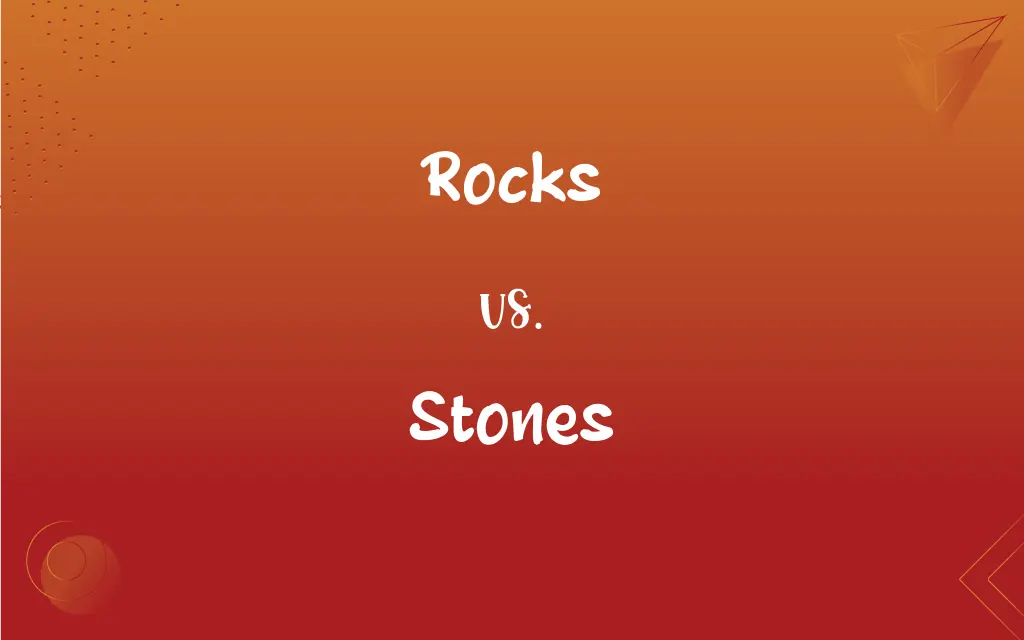Rocks vs. Stones: What's the Difference?
Edited by Harlon Moss || By Janet White || Published on December 23, 2023
Rocks are large, natural, unshaped aggregates of minerals, while stones are smaller, shaped or worked pieces, often used in construction.

Key Differences
Rocks are natural solid aggregates of minerals found in the earth's crust, varying greatly in size, composition, and formation. Stones, however, are often smaller, more refined pieces of rock, typically shaped or altered by human or environmental action.
In geology, rocks are categorized into three main types: igneous, sedimentary, and metamorphic, based on their formation process. Stones, on the other hand, are generally not classified scientifically but are known for their use in building, crafting, or as pebbles.
The term 'rock' can encompass massive formations like mountains or cliffs, highlighting its broad and unrefined nature. Stones, conversely, are commonly found in everyday settings like gardens, pathways, and as part of architectural structures.
Rocks are significant in studying the earth’s history and geological processes. Stones, though derived from rocks, are more associated with human uses such as in sculpture, construction, or as gemstones.
The texture and composition of rocks can vary widely, from smooth and homogenous to rough and heterogeneous. Stones, especially those shaped by human hands, tend to have a more uniform and smooth appearance, suited for their specific purposes.
ADVERTISEMENT
Comparison Chart
Size
Generally larger, can range from small to mountainous
Usually smaller, hand-held sizes
Formation
Natural formation, unaltered by humans
Often shaped or modified by human activity
Usage in Language
More often used in geological contexts
Commonly used in reference to construction or art
Appearance
Varied, can be rough or smooth, unrefined
More refined, often smoothed or shaped
Significance
Studied for geological and earth history
Associated more with human activities and culture
ADVERTISEMENT
Rocks and Stones Definitions
Rocks
A mass of rock projecting above the earth's surface or out of the sea.
Seabirds nested on the isolated rocks.
Stones
A piece of rock shaped for a purpose, especially a gravestone.
The engraving on the stone was weathered but legible.
Rocks
Large natural aggregates of minerals.
The valley was surrounded by towering rocks.
Stones
Hard, solid non-metallic mineral matter used for building.
The cottage was built with traditional stones.
Rocks
Solid mineral material forming part of the surface of the earth.
The path was littered with small, sharp rocks.
Stones
A unit of weight equal to 14 pounds.
She lost two stones after her new fitness routine.
Rocks
Symbolic of strength and steadfastness.
In times of crisis, she was their rock.
Stones
A gem or precious stone.
The ring was set with a brilliant blue stone.
Rocks
In music, a genre characterized by a strong beat and typically played with electric guitars.
They listened to classic rock all night.
Stones
Small pieces of rock of a size suitable for handling.
He skipped stones across the surface of the lake.
Rocks
Relatively hard, naturally formed mineral or petrified matter; stone.
Stones
Concreted earthy or mineral matter; rock.
Rocks
A relatively small piece or fragment of such material.
Stones
Such concreted matter of a particular type. Often used in combination
Sandstone.
Soapstone.
FAQs
Are rocks always large?
Not always, rocks can range in size from small pebbles to huge mountains.
Can stones be part of rocks?
Yes, stones are often smaller pieces of rocks, either naturally broken off or shaped by humans.
Are stones used in jewelry?
Yes, especially when polished and shaped, stones are used in jewelry.
Do rocks have layers?
Some rocks, like sedimentary rocks, have distinct layers.
Are all rocks naturally occurring?
Yes, rocks are naturally occurring solid aggregates of minerals.
Can stones float?
Generally, stones do not float, but some porous stones like pumice can.
Is coal considered a rock?
Yes, coal is a type of sedimentary rock.
Are stones always hard?
Most stones are hard, but their hardness can vary depending on their mineral composition.
Are diamonds rocks or stones?
Diamonds are a type of stone, specifically a form of crystalline carbon.
Can rocks be colorful?
Yes, rocks can be very colorful depending on their mineral content.
Are stones always natural?
Most stones are natural, but some can be synthetic, especially in jewelry.
Are all stones smooth?
Not all, but many stones are smoothed by natural processes or human shaping.
Do rocks grow?
Rocks don't grow in the biological sense, but they can accumulate and form larger structures over time.
Is granite a rock or a stone?
Granite is a type of rock often used as a stone in construction and decoration.
Do all rocks come from volcanoes?
No, only igneous rocks are formed from volcanic activity.
Can stones be magnetic?
Some stones like magnetite are naturally magnetic.
Is limestone a rock or a stone?
Limestone is a type of rock that can also be used as a stone in construction.
Can rocks float in water?
Generally, rocks do not float, except for some like pumice.
Are bricks considered stones?
No, bricks are man-made construction materials, not natural stones.
Can rocks be soft?
Some rocks, like talc, are relatively soft compared to others like diamond.
About Author
Written by
Janet WhiteJanet White has been an esteemed writer and blogger for Difference Wiki. Holding a Master's degree in Science and Medical Journalism from the prestigious Boston University, she has consistently demonstrated her expertise and passion for her field. When she's not immersed in her work, Janet relishes her time exercising, delving into a good book, and cherishing moments with friends and family.
Edited by
Harlon MossHarlon is a seasoned quality moderator and accomplished content writer for Difference Wiki. An alumnus of the prestigious University of California, he earned his degree in Computer Science. Leveraging his academic background, Harlon brings a meticulous and informed perspective to his work, ensuring content accuracy and excellence.































































